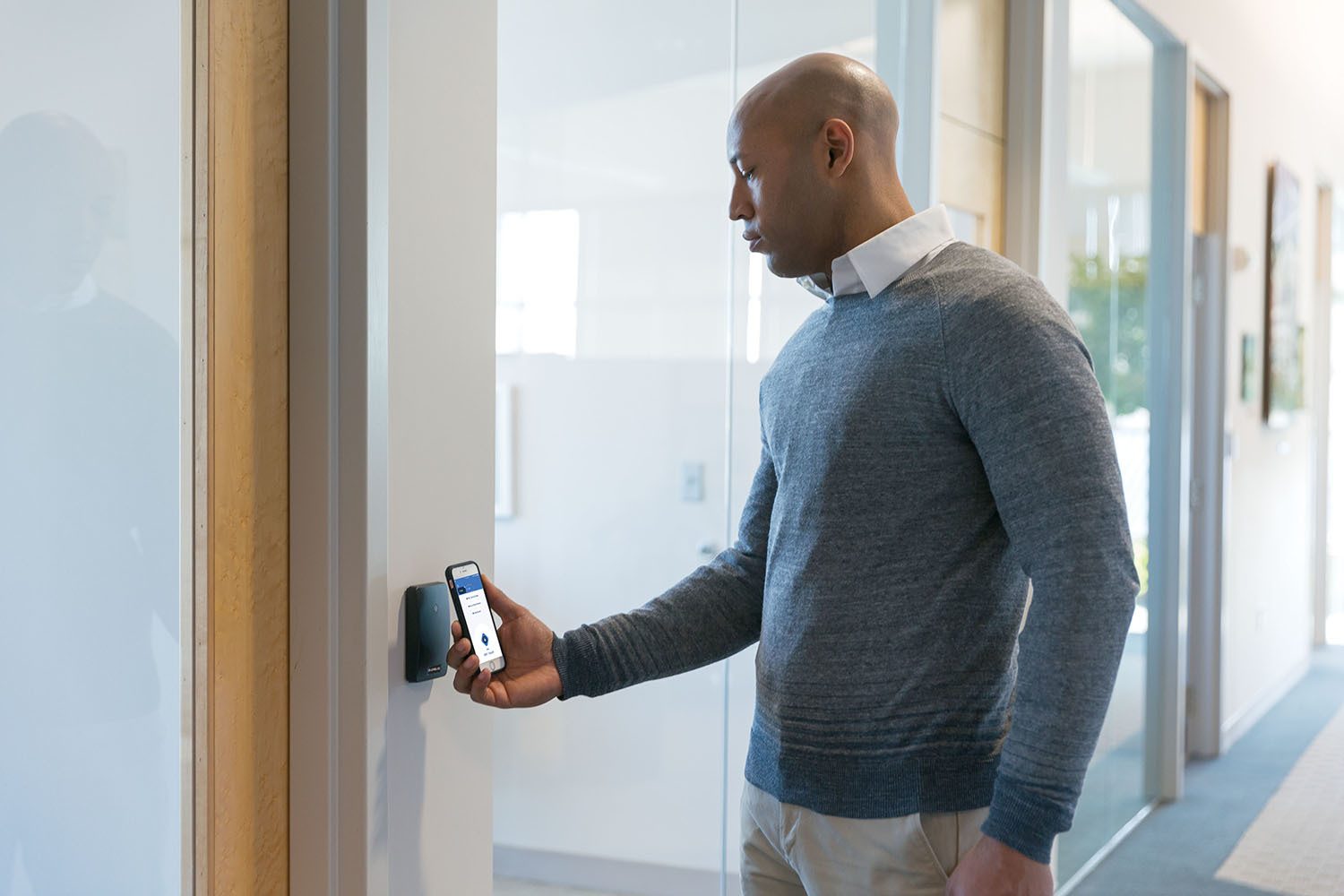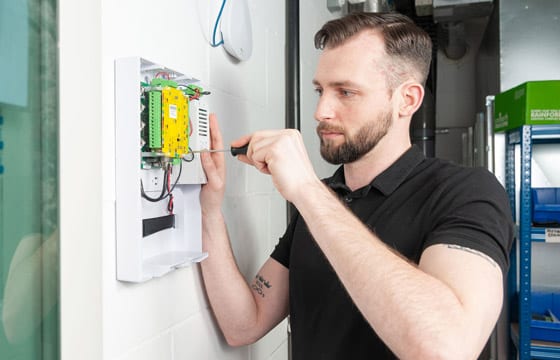// Access Control & Indentification
More End Users Demand Mobile for Readers & Credentials
More End Users Demand Mobile for Readers & Credentials
More end users are turning to mobile credentials for their reader and credential needs. Here, a user gains access through a smart watch with Paxton’s Key app.
IMAGE COURTESY OF PAXTON
While the more traditional physical card systems are still in play, security integrators are seeing an increasing demand for mobile capabilities.
By Laura Mazzuca Toops, SDM Content Editor
If the evolving state of the readers and credentials market could be boiled down into a single word, it would probably be “mobile.”
The ubiquity of smartphones in today’s world means that mobile applications for readers and credentials just make more sense for security, sources say.
“Mobile continues to be the dominant trending technology category, and while mobile credential usage as a function of overall credentials in use remains modest, the share is growing rapidly,” says Luc Merredew, product marketing director, physical access control, HID Global, Austin, Texas. “There are few security professionals that are not considering how mobile credentialing can work in their or their customer’s systems. With the launch of mobile credentials in the largest phone operating system provider, many organizations are looking to add credentials to their device wallets. … The end results are truly remarkable customer experiences.” (Merredew is referencing the recent use of contactless access through Apple Wallet by many large enterprises.)
Mobile credentials solutions offer security integrators more flexibility in managing and assisting customers and can help end users reduce costs while creating a safer entry point solution, says Hayes Whitt, commercial security senior global offering manager at Honeywell, Charlotte, N.C.
End users moving from legacy controls like a physical access card to a Bluetooth-based mobile recognitions system can save costs, improve security and enable a better user experience through frictionless credentialing and entry, he says.
Remote access also helps increase efficiencies. For instance, security dealers and integrators can often remotely resolve issues in less time, decreasing the number of physical trips needed to a particular site, Whitt adds.
The push toward deploying credentials on mobile devices is especially prevalent in higher education and many commercial enterprises, says Angelo Faenza, head of digital access solutions at ASSA ABLOY Opening Solutions Americas, New Haven, Conn. “Almost everyone has a smartphone today, and students are among the most active users of mobile apps and wallets for transactions of all kinds, from making purchases securely to getting into places safely,” he says. U.S. colleges and universities are installing thousands of electronic access control (EAC) locks for new construction and to retrofit classic campus buildings — and many are either already using mobile credentials or ready for the transition, he says.
Pictured is LenelS2’s BlueDiamond Bluetooth mobile credential solution, which is available in both a standard “per credential, per year” offering, and an unlimited credential model.
IMAGE COURTESY OF LENELS2

And because ripping and replacing legacy readers is not always cost effective or productive, new technology allows building owners to update their existing physical access systems and install intelligent mobile access solutions with minimal hardware upgrade requirements, Whitt notes. “This helps to not only upgrade to a modern, contactless building experience but also helps provide better analytics and user management capabilities, while managing the cost of upgrades.”
Richard Sedivy, director of marketing and regulatory affairs at Doorking (DKS), Inglewood, Calif., says, “Mobile credentials are certainly becoming preferable for access system users. Everyone wants their smartphone to be an all-in-one package to control everything.”
Jeffrey Jachetta, head of sales and customer success at Key Security Designs, an integrator based in Danville, Calif., agrees. “End users are overwhelmingly requesting readers that can support mobile credentials as they have become accustomed to all other things they control via their phones,” he says. “It used to be a suggestion as a ‘nice-to-have’ upgrade, which the reseller would persuade the end user to opt for. However, the feature request is now frequently being initiated by the end user as a ‘must-have.’”
The Latest in Reader & Credential Technology
What trends are driving change in the readers and credentials space? Our subject matter experts pointed out several they’re seeing in use from their customers.
Multi-tech readers with smart credentials. Jeffrey Jachetta of Key Security Designs says most of his projects are using this technology. “These readers typically come prepped to embrace mobile technology out of the box, even if the end user is not ready to make the shift today,” he says. “It does not make sense to sell 125KHz proximity-only readers any longer as there is too much likelihood the end user will want to replace them sooner than later with something that meets the latest security standards.”
More use of open standards. An increase in file transfers following the open supervised device protocol (OSDP) standards is another trend, says Mike Green of LenelS2. “Investing in readers and access control solutions that are OSDP-literate and support OSDP file transfers enables remote reader configuration and firmware updates, which can mean significant cost savings for the customer in the future,” he notes. “Gone are the days of having to take the reader off the wall, connect to a laptop and update reader firmware or flash a configuration card. Remote updates via OSDP file transfer are a key element of future-forward, efficient and scalable access control.”
Increased emphasis on security certifications. Manufacturers are upping their game when it comes to ensuring safety and security in their reader and credential systems. For example, HID launched the first TUV SEAL-5 approved physical access control credential with its 16kB Seos credential, says Luc Merredew. TUV standards represent a more stringent approach to security evaluation standards, requiring validated change management policies, communication processes and lifecycle management procedures, he adds. Merredew observes that updated DESFire technology is also becoming more popular in North America, especially with organizations that want to manage their own keysets and applications.
More use of EAC data. “We hear from integrators that access control technology’s ability to generate useful data is getting much more attention,” says Angelo Faenza of ASSA ABLOY. “Along with an audit trail of authorized comings and goings, EAC can also quantify how any and how often employees are using an office space, for example. This is valuable insight for companies in the process of rethinking how to design and revamp around the hybrid workplace.” Data capture is also being integrated with video surveillance, alarm and other security systems, as well as building management software to control HVAC and lighting based on occupancy patterns, he adds.
Ultra-wideband (UWB) radio technology. The use of UWB radio technology as opposed to Bluetooth enables the quick transmission of large amounts of data because it’s spread across a wide bandwidth, reducing power consumption, says David Ito, project manager, Camden Door Controls, Mississauga, Ontario. However, like any new technology, it will take some time for most mobile devices to have UWB built into their hardware, he says.
Near-field communication (NFC) technology. NFC, used for mobile wallets and other applications, is also being leveraged for readers and credentials, and is best suited for short-range applications such as vehicle access, Ito notes. “Bluetooth has a longer range, which may not be ideal for high-security applications but acceptable for vehicle access versus the previous button key tags,” he says.
//
The COVID-19 Connection
Like many other trends in the electronic security industry, the move toward mobile readers and credentials was accelerated by the global pandemic, when mobile credentials helped reduce physical interaction with the badging office and security team during quarantine. The use of contactless access and thermal screening technology rose dramatically during the pandemic, which carries over into today’s post-pandemic era, says Jack Barker-Davy, product manager at Paxton Access, Columbia, S.C. “For example, we launched features to our access control solution Net2, including occupancy management and checkpoint control,” he says. “We also introduced thermal camera integration. These features are enabled through the use of readers and credentials, allowing contactless access.”
Today, mobile credentials help streamline enrollment and support a hybrid or primarily a work-from-home environment, says Rachael Ratliff, director, national accounts at AMAG Technology, Torrance, Calif. “Setup is done remotely, saving time and eliminating the hassle of replacing lost, stolen or forgotten cards,” she says. “Mobile credentials are convenient and cost effective.”
Customers today also trust mobile app-based credentials more than in the past, which helps increase demand. “There used to be much more hesitancy in shifting to mobile credentials due to cybersecurity and privacy concerns, whereas it is now generally accepted that they are safer and more secure than traditional cards,” Jachetta says.
Quite simply, mobile credentials offer more security than conventional reader and credential systems, says Brach Bengtzen, director of marketing at ProdataKey (PDK), Draper, Utah. “People may share their PIN codes and let coworkers borrow their access card, but nobody is going to share or lose their phone,” he says. “Twenty-five percent of credentials are lost every year, and after two to three years, cards usually break and need to be replaced. Those hassles and associated expenses are virtually eliminated with mobile credentials.”
In industry verticals like the commercial real estate market, COVID-19 and an overall focus on the tenant experience have increased the adoption of Bluetooth and other hands-free options for access control, says Louis Boulgarides, CPP, president and CEO of Ollivier Corporation, an integrator based in Los Angeles.
Because technology continues to evolve, access control systems must be easy to install and navigate.
IMAGE COURTESY OF PAXTON

And now that businesses are welcoming workers back into the office, more are gravitating toward the use of mobile credentials, says Mike Green, senior manager, digital product management at LenelS2, Framingham, Mass. “These customers would like to enable their employees to use their devices, such as a mobile phone, to gain access into workplaces,” he says. “Often, they won’t even have to remove their phone from their pocket or bag; they can simply walk up to the reader and the secure credential automatically sends from their phone based on proximity to the entry point.”
Besides being convenient for users, mobile apps for readers and credentials also provide more security and a cost savings over physical identification cards, Ratliff says. Physical credentials such as cards and fobs can be “expensive, cumbersome and often left at home or lost, which puts the company at risk,” she says. “Employees rarely forget their phone and it’s almost always on their person, therefore it’s more convenient to use. Implementing frictionless technology provides cost savings on cards and is easier to manage.”
Barker-Davy sees more demand for mobile credentials in the access control industry in lieu of physical access tokens. Powered by Bluetooth functionality in smart devices, systems like the Paxton Key app for its access control and video management software Paxton 10 allows users to access through doors with their smartphones and smart watches. “The smart credentials, as we call them, are easy to issue and use, and are completely free of charge,” he adds.
Enhancing the Customer Experience
The availability of mobile credentials doesn’t mean that more traditional systems are disappearing, however. End users are becoming more sophisticated with their use of “conventional” RFID cards and readers, in large part because of the increased professionalism of integrators, says Merredew of HID. “As an industry, we’ve done a better job than ever before of drawing attention to the shortcomings of legacy technologies while drawing needed attention to the best strategies for designing and deploying systems today,” he says. “For example, the use of customer-specific keysets, managed formats, non-matching card marking and secure reader-to-controller communication such as OSDP v2 secure channel.”
Whether through a mobile app or physical card system, it’s important that integrators explain to their end users the importance of proprietary card technologies and the importance of key ownership.
IMAGE COURTESY OF LENELS2

Access credentials are available using smartphone Bluetooth technology, 125KHz proximity cards and tags and 13.56MHz smart cards and tags to allow access through doors, Sedivy says. Wireless radio frequency (RF) devices (transmitters) are still widely used and are often the preferred method for vehicular gate access because they allow users to access the vehicular gate from a greater distance without rolling down the car window.
Integrators are also seeing more demand for open standards such as DESFire in lieu of proprietary card technologies, Green says. “Knowledge around smart card technologies is increasing as customers realize that a downside to the commonly used proximity card technologies is that they are not encrypted and therefore less secure — for example, if they are cloned and replicated, compared to more advanced solutions,” he says.
John Calzaretta, president and CRO of Sentry Enterprises, an integrator based in West Chester, Pa., says that while more enterprises want to move away from proprietary solutions, there is “a continued reluctance within Fortune 500 enterprises to move to mobile or Bluetooth credentials. … A staggering number of enterprises continue to build upon a very vulnerable, 125KHz proximity utilization.”
Navigating Supply Chain Issues
Supply chain concerns have been especially prevalent in the reader and credential segment of the security market, throwing old paradigms out the window and forcing security industry to adapt to different products and components when needed.
The global component shortage has hit most technology manufacturers, and the electronic security industry is no exception, says Jack Barker-Davy at Paxton Access. “We’ve increased our stock levels internationally to ensure we can supply products with our standard seven-day lead time,” he says. To further adapt to component shortages, Paxton has redesigned some products to use new components, which ensures alternative options to manufacture products, he adds.
“JIT (just in time) inventory control was what I learned in business school,” says Richard Sedivy of Doorking. “That model is now obsolete and the new model seems to be ‘buy as much as you can and keep it in stock,’ inventory turnover be damned. So yes, we now purchase raw materials and supplies in far greater quantities than before so that we can keep our production lines moving.”
For integrators, supply chain issues have affected what types of readers and credentials users select for their projects, and have greatly increased lead times on installations, which can be devastating for smaller projects, says Trevor Stewart of Security Control Integrators. Projects where businesses are moving into 10,000 square feet, with much of the space already built out, need to turn around quickly. And even smaller projects require eight or 10 readers, which supply chain problems are delaying by months. “It used to be very uncommon to have spaces unsecured, but now with these delays and technology limitations, it’s unfortunately becoming more common,” Stewart says.
The situation has forced Security Control to switch products when needed and made pricing a nightmare, he adds. “We have major manufacturers adding surcharges and implementing price increases multiple times in a year,” Stewart says. “Integrators simply can’t always pass those price increases along to the customer. Sometimes parts get discontinued and the replacements are even more expensive. Shipping has also been through the roof as well as inefficient, meaning we might order 50 of the same item and still receive that order in 20 different shipments.”
Louis Boulgarides of integrator Ollivier Corporation agrees. “We have readers that we have been waiting on for over a year,” he says. “HID has made a commitment to fill many of these orders before the end of the year. If that does not happen, I think more folks are going to make a jump to a different reader technology.”
Luc Merredew of HID Global acknowledges that the company has faced delivery challenges due to supply chain shortages, but that HID remains committed to its end users and integrators. “I cannot understate how hard we are working to restore lead times of our most demanded products, nor how seriously we take the disruption and frustration delays can and do cause,” he says. "We are confident that we’re making the necessary investment and are employing the strategies to restore lead times and ultimately confidence where it is eroded, so that specifying HID products and services can be done without reservation.”
At Key Security Design, supply chain issues have caused a scramble to order additional stock of readers and cards well before customers really need them, says Jeffrey Jachetta, head of sales and customer success. “Most resellers have had to become creative and substitute reader and credential types when possible in order to avoid project delays,” he says.
Worse, increased demand for access control upgrades, combined with the global supply chain crisis, means things won’t be getting better anytime soon, Jachetta predicts. “We have tried everything possible from shifting distributors to switching product lines in order to meet deadlines,” he says. “The new reality is standardization on a single reader/credential platform obtained from a sole provider is an unsustainable practice. Sometimes we have had to install temporary readers, such as mullions instead of single gangs until the needed models arrive. This increases operational costs through additional labor hours and truck rolls that shouldn’t have needed to happen.”
The supply chain crunch means manufacturers are often struggling to find multiple sources for the same components — a move that actually strengthened manufacturing outputs, says Mike Green of LenelS2. “While we have seen an increase in some lead times, we are still able to fulfill orders for mobile credential-enabled readers in a timely manner for our customers,” he notes. “For many products, such as our DESFire cards, we have been able to maintain our standard lead times.”
Manufacturers that saw the writing on the wall early in the supply chain crisis fared better than others. “With the kinds of challenges with electronics that manufacturers across every industry faced early on, we were able to shift and launch mechanical innovations relating to thing like status indicators for our locks and solutions for school security and other applications,” says Angelo Faenza of ASSA ABLOY. “When mechanical prices rose, we looked at sustainability — an area you may not consider in the face of supply chain issues. However, when you dematerialize a product, there’s less material, labor and cost.”
//
While most of his customers have migrated to some form of smart cards, many are still using proximity cards, especially in the U.S., says Trevor Stewart, president and co-founder of Security Control Integrators (SCI), Pine Brook, N.J. Before the pandemic, the transition to smart cards was happening more quickly; but supply chain snafus are slowing down the migration, he says.
“Most of our customers are hanging in there with HID readers, even though delivery dates are not certain,” Boulgarides says. “Some people have chosen to move off HID to other products like Open Path, Brivo and other 3mil and Wavelinx readers OEMs by other access control companies.”
Education Is Key
For integrators who want to enhance their readers and credentials expertise (and sales), sources recommend staying current on the latest technology, offering customers as many options as possible and tailoring them to the end users’ specific needs.
“Now is the time to encourage an alternative to physical credentials and the market is shifting,” says Ratliff of AMAG. “Customers are looking to their integrators to be that subject matter expert and a mobile credential provides convenience, significant ROI, and cutting-edge technology.”
Higher customer expectations and constant advances in door technology mean security integrators need to stay on top of their game if they want to grow and stay relevant, says ASSA ABLOY’s Faenza. “Simply put, integrators who are most knowledgeable about the range of current advancements stand to gain a competitive edge with customers and with attracting and retaining strong employees,” he says.
Part of being that security subject matter expert is the ability to spot vulnerabilities in a customer’s system, says Jachetta of Key Security Designs. “Too often, we see vulnerable prox readers and credentials in use and end users that have little to no understanding of the risks,” he says. “Spending a few minutes to educate the client on best practices and the latest technology goes a long way.”
Although mobile credentials are growing more popular, card reader systems are still in demand. Pictured is AMAG’s Symmetry access control system with smartcard, although AMAG’s Bluetooth readers also work with Symmetry apps for mobile phone access control.
IMAGE COURTESY OF AMAG TECHNOLOGY

In light of today’s supply chain challenges, integrators need to be aware not only of market trends, but product availability, says PDK’s Bengtzen. “Be flexible,” he says. “Supply chain issues aren’t going away any time soon. It might be time to explore new ways to deliver on access control projects.”
And because many organizations are handing off the control of physical security to their IT departments, it’s important to understand how these departments work, Calzaretta says. “Learn how to speak the language of IT and look to provide a credential that truly proves the holder’s identity and can be used for multiple use cases: physical security, IT and OT,” he says.
Finally, integrators need to be flexible enough to roll with the punches still being delivered by supply chain issues and changes in emerging technology, Stewart says. “The one piece of advice I’d offer everybody is be flexible and educate yourself on the technology,” he says. “Educate yourself to understand the upsides and downsides to the different technologies available so that when you have to be flexible and find alternative solutions, you don’t make a knee-jerk change and end up with a bigger problem down the road.” SDM

